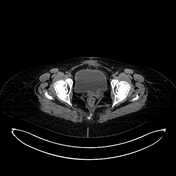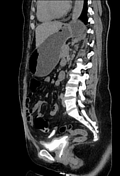Presentation
Urinary incontinence with a recent history of total abdominal hysterectomy and bilateral salpingo-oophorectomy, along with a history of double J ureteric stent insertion followed by its removal.
Patient Data









a fistula is seen communicating between the posterior urinary bladder and the upper part of the anterior vaginal wall. Contrast media passes through the vaginal canal
mild circumferential, uniform mural thickening of the urinary bladder is noted, with a few internal air loculi. Associated mild smudging of the surrounding fat planes
non-orthotopic insertion of both ureters is seen at the anterolateral and superior aspects of the urinary bladder. Associated mild dilatation of the left ureter and left pelvicalyceal system, with no evidence of obstructing stones
Case Discussion
This case illustrates a vesicovaginal fistula resulting from a total abdominal hysterectomy with bilateral salpingo-oophorectomy, leading to urine discharge through the vagina.
The most common causes of vesicovaginal fistula formation are prolonged obstructed labor and surgical procedures such as hysterectomy as in this case. Other risk factors include pelvic malignancies (e.g., bladder or endometrial carcinoma) and radiotherapy.




 Unable to process the form. Check for errors and try again.
Unable to process the form. Check for errors and try again.